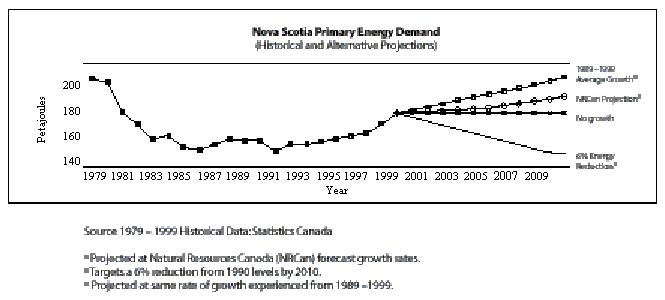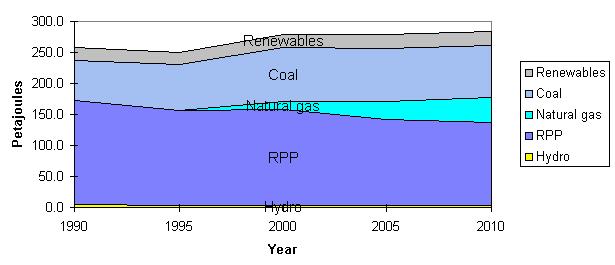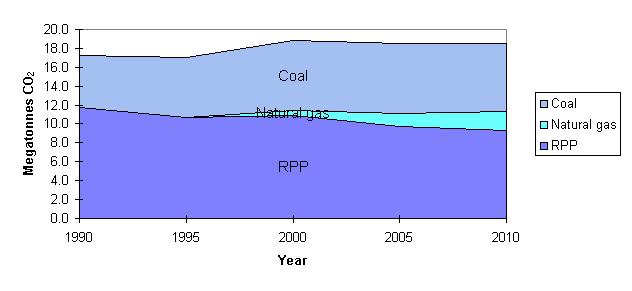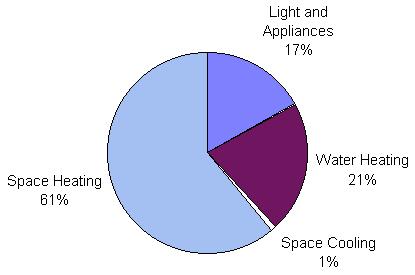
Global climate change from anthropogenic greenhouse gas emissions may manifest itself in a number of different ways, from increased desertification to loss of habitat. Many coastal regions, including almost all of Nova Scotia, will be particularly vulnerable to some of the predicted effects of climate change, notably sea-level rise and extreme weather events. A sea-level rise of less than half-a-metre, coupled with a high-tide and a storm surge could severely disrupt the lives of many people living in low-lying communities along much of the Atlantic coast and the Bay of Fundy [1].
At some 19.8 tonnes of carbon dioxide (and carbon dioxide equivalent) per person per year, Nova Scotians are amongst the world's top emitters of greenhouse gases, although slightly below the Canadian average of 20.8 tonnes per person per year [2]. In December 1997, Canada signed the Kyoto Protocol, agreeing to cut its greenhouse gas emissions to 94 percent of 1990 levels by 2008-2012 [3]; if these targets are to be met, Nova Scotians will be expected to make significant changes in their energy consumption habits.
The document, "Powering Nova Scotia's Economy", makes several references to climate change and the greenhouse effect. This report reviews the material on climate change in the document and then discusses ways in which Nova Scotians could decarbonize their economy.
"Powering Nova Scotia's Economy" refers to climate change and greenhouse gas emissions in several sections, two of which are reviewed here.
On page vii of this section, the authors present a chart, titled "Nova Scotia's Primary Energy Demand", which is reproduced here:

Despite its title, the data in the above chart does not refer to primary energy demand. According to the document (page v), Nova Scotia's primary energy demand in 1999 was 269.4 PJ; the chart shows a value below 180 PJ. It is possible that the chart refers to Nova Scotia's end-use energy demand (page v of the document states that end-use demand in 1999 was 179.0 PJ). End-use energy demand refers to energy that is used by a sector where the energy could have undergone a transformation (for example, coal or oil to electricity). Anyone interested in the total greenhouse gas emissions from Nova Scotia should examine primary rather than end-use energy data.
The authors have completely misunderstood the meaning of the six percent reduction pledged by Canada at Kyoto. Canada pledged a six percent reduction in emissions not a six percent reduction in energy demand (primary or end-use) [3].
This is more than semantics; consider:
Document pages xxxiii and xxxiv are devoted to the problem of global climate change. The authors of the document present a brief summary of the problem and include a discussion of Nova Scotia's role, in light of Canada's committment to cut its greenhouse gas emissions to 94 percent of 1990 levels by 2008-2012 (in other words, a six percent reduction).
On page xxxiv, the document states "Nova Scotia's GHG emissions had risen from 19,400 kilotonnes (kt) equivalent of CO equivalent to 20,100 kt of CO equivalent by 1998. [...] Emissions are estimated to be 21,100 kt of CO by 2010. Achieving a 'Kyoto-like' target in the reduction of emissions would require a 16 percent reduction from a business-as-usual forecast."
The "16 percent emissions reduction" is incorrect:
The 16 percent emissions reduction is incorrect because it is based upon incorrect information, presumably obtained from Voluntary Planning's "Climate Change Workbook" (issued as part of the Government of Nova Scotia's consultations held with stakeholders in 1999) [6]. Page 7 of the Climate Change Workbook states that in 1990, Nova Scotia's emissions were 19.4 million tonnes of CO and that a six percent reduction would give a reduction target of 17.7 million tonnes. As has been shown above, six percent of 19.4 million is 18.2 million, not 17.7 million.
Page xxxiv of this section lists the following options for reducing emissions (there is no suggestion that this list is exhaustive):
Fugitive methane from underground coal mining has been decreasing significantly over the past decade as provincial coal mines have been closed (1.2 Mt to 0.83 Mt CO equivalent between 1990 and 1996 [5]). This number will probably continue to decrease. Interestingly, a significant source of fugitive methane comes from natural gas production and transportation [5]; meaning that provincial pipelines may replace coal mining as Nova Scotia's principle source of fugitive methane.
CO capture is intended for stationary power plants; CO from automobiles is problematic because of the complexities associated with fitting the necessary equipment on every automobile.
The concept works in principle, but requires monitoring agencies to verify that targets have truly been met. Furthermore, the cost of not meeting the required targets must be such that missing a target will become a financial burden on the organization (another reason why many developed countries that are heavily dependent upon fossil fuels are reluctant to join emissions trading schemes).
Before considering emission reduction strategies, it is worthwhile examining NRCan's primary energy demand projections for Nova Scotia and the resulting greenhouse gas emissions.
The following chart is NRCan's historical (1990 and 1995) and projected (2000, 2005, and 2010) primary energy demand for Nova Scotia [4] (RPP is the abbreviation for Refined Petroleum Products):

Over the next decade in Nova Scotia, NRCan projects that natural gas will come on-stream, displacing oil in the commercial, industrial, and residential sectors as well as for electrical generation. However, natural gas is projected to make little impact on coal consumption (for electrical generation). Primary energy demand is expected to grow from 253.0 PJ in 1990 to 281.2 PJ in 2000 and 285.6 PJ in 2010.
The effect of the introduction of natural gas to the energy mix would be expected to make a significant impact on the province's greenhouse gas emissions. However, as the following chart shows, this is not the case because energy consumption is projected to increase, diminishing the benefits of 'cleaner' natural gas:

If NRCan's projections are correct, the decline in CO emissions from energy sources will be gradual, peaking at 18.9 megatonnes in 2000 and holding steady at 18.5 megatonnes for 2005 and 2010.
The following assumptions were made in the creation of the above charts:
In the document (and elsewhere), greenhouse gas reduction is portrayed as a monolithic action, applied to the entire economy. This approach is naive, since it fails to recognize that the economy is made of various sectors, each with its own energy requirements. By examining each sector individually, emission reduction strategies can be tailored to the energy requirements of the sector, potentially making it more acceptable to the public at large.
The 1996 energy-related CO and CO-equivalent emissions for Nova Scotia are as follows [5]:
| Sector | Emissions (kt) | Percentage |
|---|---|---|
| Electrical generation | 7,280 | 40.4% |
| Transportation | 5,200 | 29.2% |
| Residential | 2,000 | 11.2% |
| Industrial | 1,479 | 8.3% |
| Commercial | 786 | 4.4% |
| Fugitive | 830 | 4.6% |
| Other | 228 | 1.3% |
| Total | 17,800 | 100% |
Emission reduction strategies for the four sectors of the Nova Scotia economy as well as electrical generation are now considered.
Many emission reduction strategies for the residential sector focus on replacing existing lighting systems with more energy efficient systems. Although this will make an impact, more significant reductions can be achieved by considering total residential energy demand. For example, in 1995, Canada's residential energy demand was as follows [9]:

This chart shows that with the exception of electricity for lighting and appliances, the majority of the energy used for residential purposes in Canada is for space and water heating.
In 1997, residential energy use in Nova Scotia was 48 PJ, primarily from oil (25.4 PJ), electricity (13.2 PJ), and wood (8.1 PJ) [4]. Based upon the Canadian residential energy demand, one can assume that oil, wood, and some electricity were used for space heating. Using oil and electricity for space heating is an extremely inefficient use of expensive 'high-grade' energy sources. Sustainable alternatives to oil and electricity exist and should be considered for space and water heating as part of a provincial energy policy:
District heating offers numerous advantages: more efficient use of energy, improved air quality (by reducing the number of furnaces in a neighbourhood), local employment, and choice of fuels (since the hot water is not dependent upon the fuel source).
District heating is an extremely efficient use of energy: it replaces two fuel sources (one for electrical generation and the other for space/water heating) with one fuel source (part for electrical generation and the 'waste' part for space/water heating). In fact, district heating is an example of how 'saving the environment' actually 'saves money', since less fuel is consumed to perform two tasks.
At present, only cities and towns that are near existing thermal power stations can realistically take advantage of district heating systems. However, in those cities and towns that are not located near a thermal power station, smaller 'combined heat and power' (or CHP) plants can be built to generate electricity and heating water. The source of energy for CHP plants can be existing fossil fuels or other fuel sources, such as biomass [10].
Commercial and institutional energy demand in Nova Scotia in 1997 was 23.5 PJ from electricity (10.4 PJ), oil (11.4 PJ), and liquid propane gas (1.8 PJ) [4]. The application of commercial and institutional energy demand in Canada in 1995 is represented by the following chart [9]:

As with residential energy use, significant energy reduction could be achieved by meeting space and water heating requirements (currently satisfied by electricity and oil) with district heating, passive and active solar, and improved insulation.
Nova Scotia's industrial energy demands have averaged about 50 PJ per year (NRCan predicts this trend to continue to at least 2010). In 1997, Nova Scotia's industrial energy demand was 50.8 PJ, primarily from electricity (10 PJ), oil (26.9 PJ), and pulp spenting and wood waste (10.1 PJ) [4].
Over the past decade, significant improvements in energy usage have taken place in much of Canada's industrial sector, to keep costs down and remain competitive with foreign companies [9]. The industrial sector is a twist on 'helping the environment' and 'saving money'; in this case, by keeping Nova Scotia's industrial sector competitive through improvements in energy efficiency (i.e., 'saving money'), it is possible to help the environment.
At 29.2 percent, transportation is the second largest emitter of greenhouse gases in the province (5,200 kt CO-equivalent). In 1996, the top three greenhouse gas emitters in the transport sector were ('percentage' refers to percent of the provincial total energy-related CO and CO-equivalent emissions):
| Vehicle Type | Emissions (kt) | Percentage |
|---|---|---|
| Gasoline Automobiles | 1,580 | 8.8% |
| Light-Duty Gasoline Trucks | 1,140 | 6.4% |
| Heavy-Duty Diesel Trucks | 895 | 5.0% |
It is impossible to examine the transportation sector without taking into account a multitude of factors, including:
Although transportation is central to our 'lifestyle', it is widely acknowledged that continued growth in auto-centric transportation is unsustainable [11]. With this in mind, it is time to re-think how people and goods are transported in Nova Scotia. By reducing our dependence on the automobile, energy demand can be reduced with an associated fall in greenhouse gas emissions.
Technological change, such as the introduction of novel fuels, may well reduce greenhouse gas emissions, but the problems associated with the automobile (some of which are listed above) will remain.
Nova Scotia required 99.6 PJ of fuel for electrical generation in 1997: coal (86 PJ), oil (10.1 PJ), and hydro-electric (3.5 PJ) [4]. The end-use demand for electricity amounted to 33.6 PJ from the following sectors: residential (13.2 PJ), commercial (10.4), and industrial (10 PJ). The difference between the fuel required for generation (99.6 PJ) and the electricity consumed (33.6 PJ) is 66 PJ; one or two PJs were used within the generating stations. The remainder, about 64 PJ, was discarded as 'waste' heat (actually thermal pollution) from thermal power stations to the environment.
(As discussed previously, much of this 'waste' heat could be used in district heating systems for low-grade heating requirements in the residential and commercial sectors. District heating would make a sizeable impact on greenhouse gas emissions in towns and cities that are located near existing fossil fuel thermal power stations, such as Tufts Cove in Halifax/Dartmouth [12].)
In addition to district heating, another way in which greenhouse gas emissions can be reduced is to replace existing thermal power stations (i.e., coal and oil-fired) with renewable energy sources, including some of those suggested in the document (page xxvi): biomass, solar, wind, and small-scale hydro. All of these technologies are 'mature' in that they have proven track records around the world. Furthermore, Nova Scotia has excellent potential for many of these technologies; for example, the off-shore wind regime has the potential to supply up to ten times Nova Scotia's current electrical energy needs [13].
The development of renewable energy in Nova Scotia is being hampered, in part, by Nova Scotia Power's pricing arrangements, which discriminate against independent power producers. Other jurisdictions encourage independent power producers by requiring utilities to 'wheel' power across their grid.
Another approach which is gaining widespread acceptance in the United States is the introduction of 'Renewable Portfolio Standards' (RPS), in which utilities are required by law to include renewable energy in their energy mix. RPS is different from existing 'green power' schemes in that the utility cannot charge a differential fee for renewable energy. Most RPS schemes require their utilities to supply a small percentage of their power as renewables; this percentage increases each year until it reaches a maximum, which must be maintained by the utility (for example, see [14]).
From reading "Powering Nova Scotia's Economy", it is clear that the Nova Scotia government is more interested in oil and natural gas than they are in the problem of greenhouse gas emissions and climate change. Despite this lack of interest, there is an underlying problem that will not go away - the price of fossil-fuel based energy is rising and will continue to rise in step with increasing world demand [15]:
The most obvious way of solving this problem is to decarbonize Nova Scotia's economy. If Nova Scotians were to reduce their consumption of fossil-fuels using the measures outlined in this report, not only would they be 'saving money' (by using energy more efficiently), they would also be 'saving the environment'.
Despite what has been said about off-shore oil and natural gas, it will not last forever. To build an 'energy strategy' on these fuels is folly. What is needed is a sustainable energy policy that will ensure the energy future for all Nova Scotians, such a policy would:
By developing a policy such as the one described above, Nova Scotians will become leaders in the field of sustainable energy, gaining knowledge and expertise that could be shared with the world. And, by the way, will reduce their greenhouse gas emissions.
The author would like to thank Andy George, Vanessa Kind, and Dr. Tim Little for their assistance with this report.
For futher information on this report, please contact larry.hughes@dal.ca
Last updated: 31 May 2001